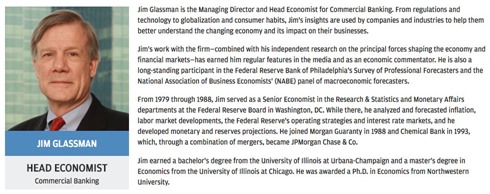How much longer can sustained economic growth continue?
Posted By RichC on April 17, 2018
![]() Have you filed your income tax return yet? 2017 returns are due today!
Have you filed your income tax return yet? 2017 returns are due today!
While catching up on some reading while out of town this week, Jim Glassman, Head Economist at JPMorgan Chase, had me pondering (and tweeting) about the length of sustained growth that might be possible after the recession. He, and many others, have pointed out that “at 106 months, the current recovery has surpassed the prolonged economic expansion of the 1960s to become the second-longest period of sustained growth in recent history.” Those of us referencing history and noting the average of 7-8 years between recessions are starting to get a bit concerned. That said, the tepid recovering during the Obama years and business jolt due to tax cuts kicking in this years should be enough to keep the present business growth cycle going. Glassman’s analysis is that “The Recovery Still Has Room to Run.”
MARKETS AND ECONOMY
The Recovery Still Has Room to Run
As the current expansion takes the silver medal for longevity, some are wondering when the peak of the business cycle will finally emerge. But there are reasons to believe this recovery has more room to grow before reaching its natural limit.At 106 months, the current recovery has surpassed the prolonged economic expansion of the 1960s to become the second-longest period of sustained growth in recent history. Despite its longevity, the present business cycle has yet to show signs of aging—the economy continues to create jobs at an above-trend pace while inflation remains tame. The financial imbalances that marked the end of previous business cycles have not emerged, a sign that today’s expansion may persist for some time.
One explanation for the recovery’s durability is that the economy entered the expansion in such a weakened state that it required years of rapid growth to regain its recessionary losses. But structural changes may also be providing stability. The increasing importance of services and the emergence of new technological efficiencies may be tempering the historic drivers of volatility in the business cycle.
Recovering From a Deep Deficit
When the recovery began in June 2009, headline unemployment peaked at 10 percent, more than double the 4.5 percent unemployment rate that marked the lowest point of the prior business cycle. This figure doesn’t even capture the millions of discouraged workforce dropouts who represented a hidden source of labor market slack.As such, the current expansion started with plenty of room to run. The economy was operating far below its potential, capable of sustaining years of above-trend growth before approaching the natural limit of its productive capacity.
Now that the economy has recovered its recessionary losses and unemployment has fallen within the range historically considered full employment, there is still little sign that this business cycle is ending. While job growth faltered somewhat in March, the economy has created an average of 202,000 new jobs every month in 2018—more than the monthly averages in both 2016 and 2017. Job creation is vastly outstripping the underlying population growth rate, yet inflation remains near the Federal Reserve’s official 2 percent target.
The Fed’s forecasts call for unemployment to fall even further before the peak of the business cycle arrives. This may represent a technology-driven structural shift in the sustainable rate of unemployment: When businesses relied primarily on job boards and classified ads to fill new positions, a sizable unemployed population was necessary to keep the economy moving. In the business cycles of the 1960s and ’70s, approximately one in every 20 workers needed to be searching actively for a new job in order to keep up with the labor market’s demand. But today’s workforce is highly flexible and the Internet enables a more efficient hiring process, so less slack may be necessary to keep the labor market running smoothly.
Over the past three decades, headline unemployment has fallen near or below 4 percent without causing the economy to overheat. Indeed, the natural rate of unemployment may have fallen.
A Shift to Services
In past decades, recessions have been driven in part by a boom-and-bust cycle in durable goods and capital investment. Goods and investment activity are vulnerable to technological and supply shocks, which can disrupt consumer demand and cause businesses to postpone new expansions. As the nation grows wealthier, however, services are taking a larger share of economic activity. Since services are less easily stockpiled, the sector sees less volatility in demand.The more volatile cyclical components of the economy currently account for only 24 percent of GDP, down from their historical average of 29 percent at the top of previous business cycles. This is likely due to the growing importance of information technology, as well as the rise of just-in-time inventory and manufacturing systems that allow businesses to minimize overproduction.
The business cycle is not completely tamed. Eventually, the economy will reach the limits of its productive capacity, and the current period of expansion will draw to a close. But structural changes in the labor market and the composition of the economy may be pushing that day further into the future.

Comments